Aven Marzal
Aven-Grotte de Marzal - Musée du monde souterrain - Zoo préhistorique
Useful Information
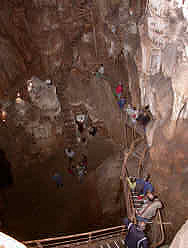

| Location: |
106 Rte de Plance, 07700 Saint-Remèze.
Gorges de l’Ardèche (07) 12 km from the Rhône Valley. 18 km from Vallon Pont d’Arc. (44.3695888, 4.5105687) |
| Open: |
JUN to AUG Mon-Fri, Sun 10:30-17:30. [2025] |
| Fee: |
Cave:
Adults EUR 11, Children (6-13) EUR 7.50, Children (3-5) free. Zoo Préhistorique: Adults EUR 9.50, Children (6-13) EUR 7.50, Children (3-5) EUR 5.50. Cave + Zoo Préhistorique: Adults EUR 17, Children (6-13) EUR 12, Children (3-5) EUR 5.50. Musée du monde souterrain: free. [2025] |
| Classification: |
 Karst Cave Karst Cave
|
| Light: |
 LED LED
|
| Dimension: | T=10 °C. |
| Guided tours: |
VR=130 m, D=50 min, St=730.

Audioguides: 


|
| Photography: | allowed |
| Accessibility: | no |
| Bibliography: | |
| Address: |
Aven-Grotte de Marzal, Route des Gorges, F-07700 St Remèze, Tel: +33-4-75-04-12-45.
E-mail: |
| As far as we know this information was accurate when it was published (see years in brackets), but may have changed since then. Please check rates and details directly with the companies in question if you need more recent info. |
|
History
| 1812 | a man named Marzal was killed by a shepherd and thrown into the cave. |
| 1892 | explored by
 E.A. Martel. E.A. Martel.
|
| 27-MAR-1949 | rediscovered by Pierre Ageron. |
| 1954 | rediscovered and developed as a show cave. |
| 1983 | Prehistoric Zoo created. |
| 2019 | LED light installed. |
Description

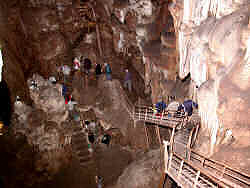
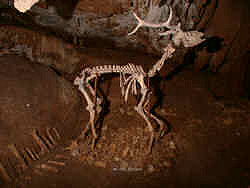
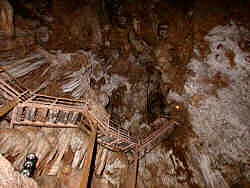
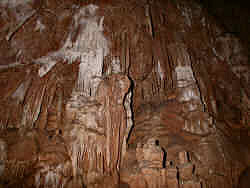

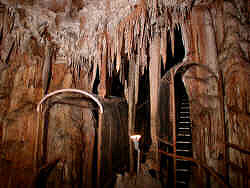
Discovered in 1892 by the pioneer French caver E. A. Martel, who described the Aven Grotte de Marzel as being of great beauty. However, subsequently the entrance was closed until March 1949 when French speleologists rediscovered it. After that the cave was forgotten for over 50 years, and because the natural entrance was only 1 metre wide and over the years vegetation had hidden the entrance, it took 15 years to find it again. The cave is named after a local man called Marzal. In 1812 he got into a fight with a shepherd and was killed. The shepherd threw Marzal and his dog down the cave. Three days later they found the body of Marzal at a depth of 12 meters, the dog fell much deeper and they found him 80 years later at a depth of 63 meters. His bones were left where they fell, and they can still be seen today. Quantities of other animal bones were found in the cave, but they all fell in by accident.
Since then the cave has been opened up to the public. A shaft was drilled into the roof of the main chamber and a 135 m deep iron staircase fitted. As one descends the stairs an amazing view of the cave is achieved. This enormous chamber is highly decorated by a marvellous array of colourful speleothems which vary from dark brick-red to snow-white.
Other attractions include, the Museum of the Underground World, which contains a collection of authentic caving equipment used by such renowned speleologists as E-A Martel, de Lavaur, de Joly, Cateret, Ageron, etc etc.
In 1983 the site was complemented with the first Prehistoric Zoo in France. Here are displayed life-size reproductions of extinct animals along an 800 m shaded path which is accessible to everyone. Some scenes are animated and benefit from an absolutely exceptional and unique PA system.
Text by Tony Oldham (2003). With kind permission.
The Aven Marzal has a really strange exploration history. The original entrance of about one metre in diameter was known to the locals, at least a few. The first time it became widely known, was after the murder of Mr Marzal. At this time it was entered to salvage the dead body, but it seems the people did not enter the cave further. The skeleton of the dog was found many years later by E.A. Martel.
The cave was still known in 1882, when
 E. A. Martel
entered it and discovered the impressive cavern below the aven (entrance shaft).
He described it well, and with his companion Louis Armand he made a cave map.
This was not a survey as we today understand it, but what we would call today a sketch or draft.
Nevertheless, it was really accurate and redrawn accurate and detailed afterwards.
And it seems this is the only map which exists of this cave until today.
E. A. Martel
entered it and discovered the impressive cavern below the aven (entrance shaft).
He described it well, and with his companion Louis Armand he made a cave map.
This was not a survey as we today understand it, but what we would call today a sketch or draft.
Nevertheless, it was really accurate and redrawn accurate and detailed afterwards.
And it seems this is the only map which exists of this cave until today.
The small entrance was soon forgotten, and bushes grew on top.
As a result, the next generation of speleologists could not find it.
They knew the accurate descriptions of the cave interior, but Martel never thought about describing the location of the entrance.
And so over many years speleologists like
 Robert de Joly
searched for the lost entrance.
During this research many other caves were found, like Marzal Deux (Marzal Two) and Marzal Faux (Fake Marzal) which are, despite the names, big and impressive caves themselves.
Robert de Joly
searched for the lost entrance.
During this research many other caves were found, like Marzal Deux (Marzal Two) and Marzal Faux (Fake Marzal) which are, despite the names, big and impressive caves themselves.
Each cave at the Ardeche has its own specialty and its own beauty. Aven Marzal is not the most beautiful cave, and does not have the most impressive concretions. It has huge stalactites and stalagmites, flowstone along the walls and some excentriques and cave coral. In other cave regions it would be an outstanding cave, here it is only second. But there is one thing which makes this cave really special and worth a visit, that’s the depth and the technical difficulty to develop it. The path goes down 130 meters and then back up. It was constructed in 1954 and never renovated, and although it is narrow, shaky and rusty, it is still in its original state. We do not know if someone official checks the cave for safety, but we doubt it. At least the French safety rules seem to be rather lackadaisical.
Through the narrow entrance shaft spiral iron stairs wind down almost vertical. After 12 m a sign states that this was the location where the dead body of Monsieur Marzal was found. Then the room opens up and the stair goes down to the floor of the hall along a wall covered by flowstone. To harm the flowstone as little as possible, the stair was built half a metre away from the wall.
This is the Grande Salle (Great Hall), the biggest chamber and the only part of the cave withsome level floor. The walls of the huge chamber are covered by flowstone, and there is a huge stalagmite right in the middle. On the other side there are more spiral staircases going up to the surface. This is the exit, using some natural passages and shafts and then a long artificial tunnel.
The whole cave is developed with a sort of double path. There are always two stairs or double stairs, with people going down the right side and going back up the other side. Only here in the main chamber, the paths meet. The whole cave is more or less a single chamber with a steep floor. The end is around 130 m deep, the path going down probably to a depth of 126 m. We do not know, because even the owners do not. They give a depth of 130 m, 126 m, 125 m and 123 m at the same time. We guess that’s a result of the missing survey. However, they are sure about the 730 steps.
At a depth of about 100 m, there is the Salle des diamantes (Hall of Diamonds), which was dubbed so by its discoverer E.A. Martel. This side chamber is covered by glittering flowstone, but it seems some of the sparkling "diamonds" have gone since Martel was here. The lowest point of the cave is probably the most impressive part. Called Salle des Colonnes (Chamber of Columns), it shows a huge number of column like stalagmites and walls and floor are covered by calcite crystals.
There are two sights at the surface, which may be a good way to invest your time while waiting for the guided tour. One is the musée du monde souterrain (Museum of the Underground World), wich has been collecting authentic equipment used by the most renowned French speleologists like Martel, de Lavaur, de Joly, Casteret, or Ageron. It shows their original equipment, caving gear, some mannequins show how the explorers looked when they went into caves. It also presents the most important books they wrote. The museum also has an archaeological exhibition which shows fossils and objects discovered during explorations and digs on the Marzal site and elsewhere. There is a baby mammoth cast, dinosaur eggs, bones of cave bears, sabre-toothed tigers, and velociraptors. And there is a collection of unique speleothems like cave pearls. The museum is free. Rather weird is the "Prehistoric Zoo", on the other side of the road, which is actually a collection of life-sized sculptures of dinosaurs.
The open hours of the cave were reduced dramatically quite recently, it is open only a few Months in summer. The dinosaurs are open as before though. We could not find out the reason for this closure, the official statement is that they want to protect the cave by reducing the visitors.

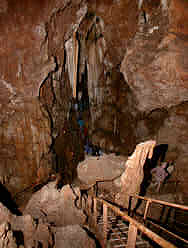
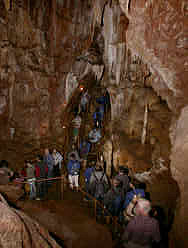
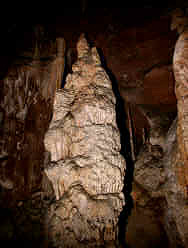
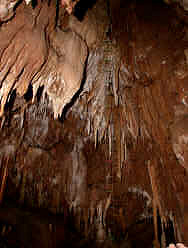
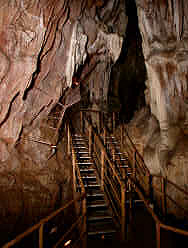
 Search DuckDuckGo for "Marzal Cave"
Search DuckDuckGo for "Marzal Cave" Google Earth Placemark
Google Earth Placemark OpenStreetMap
OpenStreetMap Aven Marzal, official website (visited: 16-AUG-2025)
Aven Marzal, official website (visited: 16-AUG-2025) Index
Index Topics
Topics Hierarchical
Hierarchical Countries
Countries Maps
Maps